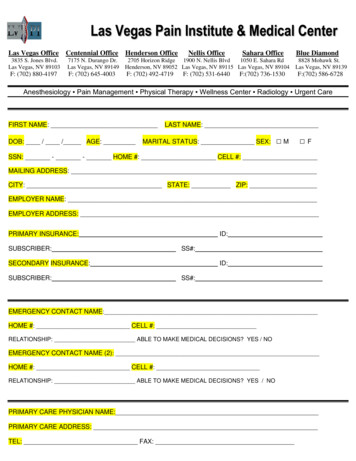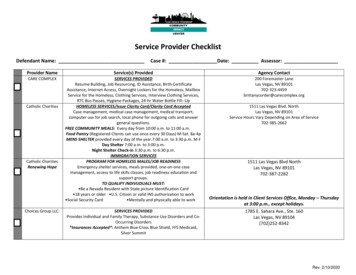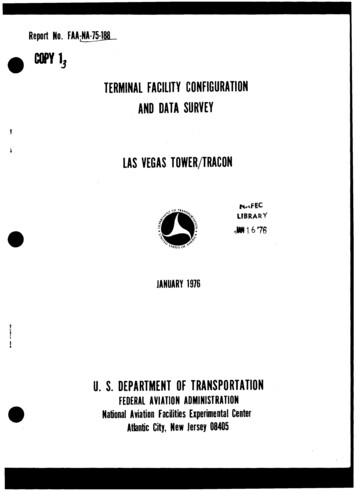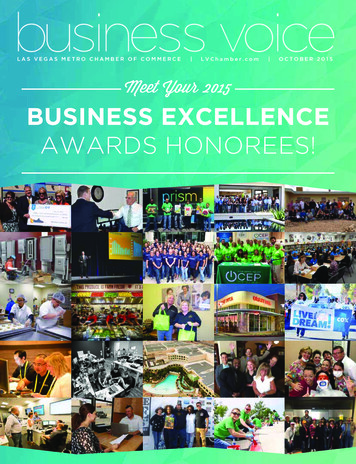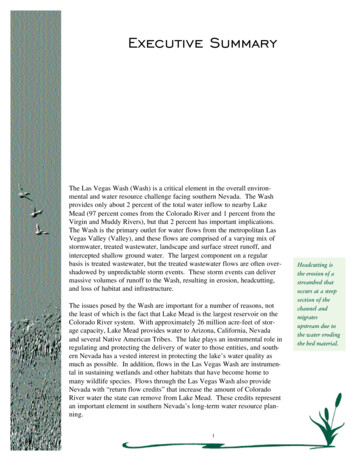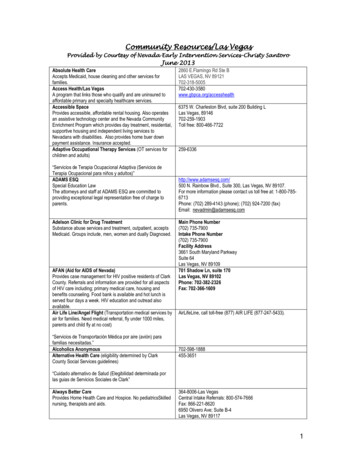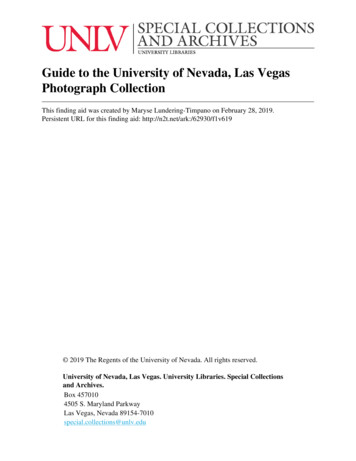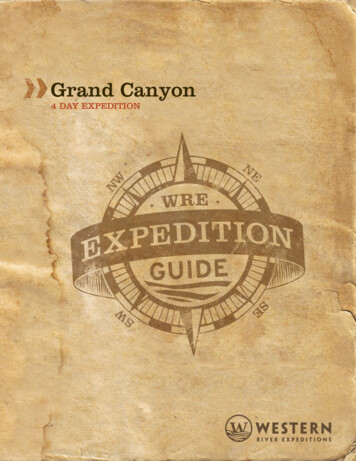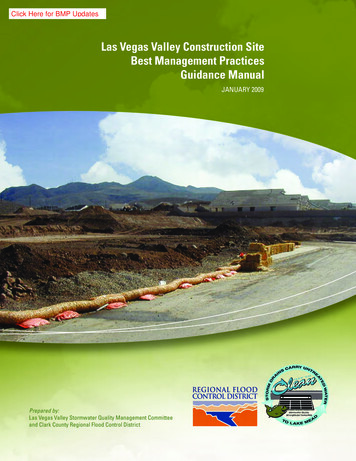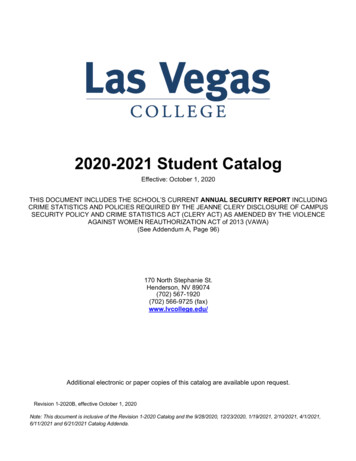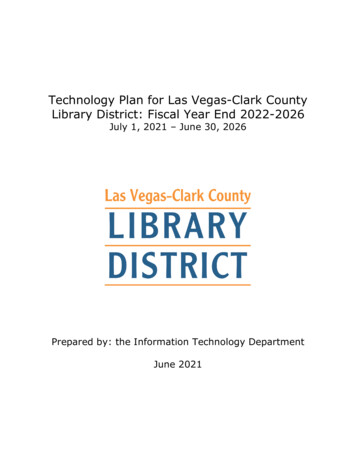
Transcription
Technology Plan for Las Vegas-Clark CountyLibrary District: Fiscal Year End 2022-2026July 1, 2021 – June 30, 2026Prepared by: the Information Technology DepartmentJune 2021
Technology Plan for Las Vegas-Clark County Library DistrictPage 2Table of ContentsExecutive Summary. 3Library Overview . 6Background Information. 9The Current State of Technology . 13Library’s Technology Goals and Objectives . 17Staff Development Strategy and Public Training . 22Timeline and Estimated Costs . 25Evaluation . 26Attachments/Appendices .1. Technology Inventory . 272. Network Diagram . 313. Internet and Wireless Use Policy . 324. Additional Information Needed for E-Rate Application. 35May 27, 2021
Technology Plan for Las Vegas-Clark County Library DistrictPage 3Executive SummaryInformation Technology in the world of public libraries has shifted radically over the pasttwo decades. Expensive and game-changing automated library operations, catalogues,materials handling, and people counting systems were launched between 2000 and 2010,cutting operations costs and making it easier for customers to find and enjoy a plethora offree public collections. Since 2000, the Library District has played a critical role in closingthe digital divide by investing in the widespread installation of free public access computers,circulating devices such as iPads and hotspots, and expanded WiFi. The InformationTechnology department of the Las Vegas-Clark County Library District (Library District) hasbeen a national leader in the development, implementation, and management of thesekinds of complex information and technology operations infrastructure and public serviceimprovements.Over the past five years, public access to technology has proliferated beyond public accesscomputers to new tech labs that provide public access to digital media, 3D printing, musicproduction, coding, and robotics technologies. At the Library District new automatedsystems have integrated functions of finance and human resources. New in-buildingcommunication technology for staff as well as new external public-facing communicationsystems have also been deployed. The world of digital collections is exploding withdatabases, materials, web-based vendors, and smart phone-based apps. Cyber security isa critical and constant complex challenge. Website and public content creation platformsare evolving to offer better search, broadcast, and customer experience capabilities.Special assets of the Library District, such as performing arts centers, require technologyupgrades for AV, lighting, and web streaming, as event technologies improve over theyears. Other library services, including the Adult Learning Program and partnership withWorkforce Connections for employment services, require connectivity for office functions, aswell as classroom, board room, computer lab, and event use.The four newest branch libraries, opened between 2009 and 2020, provided the LibraryDistrict with the opportunity to build in information technology infrastructure for even moresophisticated automated operations and public access technology amenities.Implementation of the Vision 2020 (v.2020) Strategic Plan involved development andoperational support for new technologies related to learning, business and workforcedevelopment, government and social services, and community culture. Work on the MasterFacilities Decision Framework and schematic design drawings for branch facility renovationsaim to bring the new v.2020 business model and expansive information technologyinfrastructure and services to 13 older Library District branches.The global and community contexts of Library District operations and services also influencethe development, deployment, and maintenance of Library District information technology.District-wide systems are designed to respond to rapid growth in the Vegas Valley metroarea, along with tremendously mobile and increasingly diverse service populations. Whenthe demographics of the Library District service area were mapped in 2014 and again in2019, it became clear that the Las Vegas metro area is comprised of one of the mostdiverse and geographically fragmented set of household market segments in the nation.Between 2014 and 2019 there was substantial growth of demographic groups such as Latinxpopulations and households led by single parents. Demographic analysis also indicates thatthere is a growing percentage of households with low incomes, low levels of education, lowEnglish proficiency, and low technology skill levels.May 27, 2021
Technology Plan for Las Vegas-Clark County Library DistrictPage 4Issues of low technical skills and a large percentage of households without internetconnectivity and devices other than smart phones pose a long-term challenge for regionaleconomic opportunity and workforce availability. In early 2020, as the region was beinglauded for leading the nation in new job growth in industry sectors related to medicine,transportation and logistics, and information technology, local employers were finding itdifficult to fill these new jobs with local tech-savvy workers.The challenges of the digital divide, particularly among people of color, became even moreapparent with the rapid and radically disruptive changes caused by the COVID-19 pandemic.In March 2020, for the first time in the history of the region, the entire “Vegas Strip” wasshut down and over 375,000 people lost their jobs. Tens of thousands of other localbusinesses were shuttered or curtailed activities in compliance with pandemic socialdistancing and capacity restrictions. Local residents, particularly working families,experienced more disruption as the local school district and private schools moved to onlinelearning. The Library District responded to these local conditions by pivoting to partnershipsfor online learning. In lieu of live performances and programs, library staff began creatingvirtual programs. With the shutdown, the Information Technology department ledorganizational efforts to support virtual work from home and virtual meetings. Use of digitalcollections soared by 25% over previous year usage and that level of use is holding steady.The department took advantage of CARES Act funding to expand the hotspot program andiPad lending program to help local students and businesses work at home online.After more than a year of economic and social devastation caused by the pandemic, theNevada economy is again on the rise. Sales tax (CTX) revenues are back up to prepandemic levels, and the housing market is on fire. In spring 2021 the local Board ofRealtors reported a 40% increase in home sales. With a confluence of high demand fromnew residents moving to the state and low supply, home prices have increased 14% invalue from previous years, an indicator that future property tax revenues are stable andrising.It is in the context of the above industry, national, and local conditions that this TechnologyPlan was developed. The Library District’s Information Technology department anticipatesthat 2020 budget cuts made to offset sales tax revenue losses caused by the pandemic willbe restored. In particular, the FY 2021-2022 Annual Budget replenishes funding for thedepartment’s Capital Projects Fund Technology Replacements and Upgrades Program. Oncethis essential budget restoration is made, the Library District will resume plans forrenovating older branches, funding the ILS Replacement Program in the Capital ProjectFund, and continuing to build new facilities to meet regional urban growth.An overview of Information Technology department budget expenditures, both General Fundand Capital Project Funds (CPF), are as follows:FUNDGeneral FundCPF: ILS Replacement ProgramCPF: Tech Replacement andUpgrades ProgramMay 27, 2021FY 19-20 3,704,782 0 1,167,499FY 20-21 3,895,391 0* 1,747,000FY 21-22 4,072,848 0* 1,585,000
Technology Plan for Las Vegas-Clark County Library DistrictPage 5This Technology Plan consists of 27 Goals and Objectives. Over the next five years, theLibrary District will: Continue to support the evolution of library service platforms as they evolve fromtraditional Integrated Library Systems, to support library catalogue, materialshandling, people counting, and other Library District organizational operationstechnology and systems. Continue to increase the collection of electronic and streaming materials, includingbooks, media, and music, in line with growing demand. Continue to expand and support public access technologies, including access tocomputers, internet, WiFi, and technologies consistent with the PlayBook 2026strategic plan (building on the successes of the v.2020 strategic plan). Continue to expand and support Library District internal and external digitalcommunications platforms. Continue to match the robust expansion of technological infrastructure, hardware,software, and new public access technologies with staff training, certifications, andskill-building support as well as public training and instruction to accelerate publicadoption and mastery of new technologies essential for life and work today. Continue to support technology subsidy efforts, including participation in the FCC’seRate program and the Library District and Foundation’s grant efforts. Explore and develop new apps that increase customer satisfaction, access, andawareness of Library District collections, programs, and services. Provide support for the initiatives identified in the Facilities Master Plan adopted bythe Library District Board of Trustees in September 2018.*The District has not expended any funds from the Capital Projects Fund ILS ReplacementProgram in the last three years and available resources were reallocated in FY 20-21 tooffset funding shortfalls in other capital programs.May 27, 2021
Technology Plan for Las Vegas-Clark County Library DistrictPage 6Library OverviewThe District is one of the largest, most complex public library systems in the country andthe largest library system in Nevada. The District serves approximately 1.7 million peopleover an 8,000-square-mile area. The District’s residents live in urban and suburban sectionsof the valley, small and medium-sized towns throughout Clark County, and remote ruralareas. The District’s service area includes the City of Las Vegas and most of Clark County,except for the cities of Boulder City, Henderson, and North Las Vegas. With over 640,000Library District card holders, 4.2 million branch visits, 1.3 million computer session, andover 500,000 program participants in 2019-2020, the Library District is one of the liveliestpublic libraries in the nation. Of the 9.1 million items checked out that year, 1.5 weredigital books, movies and music. Nationally, the Library District ranks 11th in circulation ofmaterials, 14th in number of visits per year, and 14th in size of population served. There arenow 25 branches in urban, rural and suburban locations. The District has been recognizednationally for excellence, including being named "Library of the Year" by Gale/LibraryJournal in 2003 and as a recipient of the 2014 National Medal for Museum and LibraryService.The District was created in 1965 when a taxing district to provide library services to servevalley residents outside the Las Vegas city limits was created by the Clark County Board ofCommissioners. It was originally named the Greater Clark County Library District, latershortened to the Clark County Library District. The District grew as other taxing districts,created to provide library services in other parts of Clark County, were added to it. Soonafter, came a contract with the City of Las Vegas to manage libraries located within the LasVegas city limits. In 1985 the District took its current form through legislation enacted bythe Nevada State Legislature and became known as the Las Vegas-Clark County LibraryDistrict, the state’s first consolidated library district, and the branches of the Las VegasLibrary formally became a part of the District.As an independent taxing district, the Las Vegas-Clark County Library District is neither apart of the City of Las Vegas nor of Clark County. It is governed by a ten-member Board ofTrustees, five of who are appointed by the Clark County Board of Commissioners and fivewho are appointed by the Las Vegas City Council. The Board of Trustees appoints anExecutive Director, adopts policies, approves the annual budget and ongoing expenditures,and sets an annual property tax levy. The Board’s roles and responsibilities are enumeratedin Nevada Revised Statutes Chapter 379.The District has a total of 25 facilities, 14 in the urban core of the Las Vegas Valley and 11in the rural or outlying Clark County municipalities, ranging from Indian Springs in thenorth, to Laughlin in the south, to Mesquite in the east, and Sandy Valley in the west.Administrative and support functions are located at the Windmill Library and Service Centerin the southwestern part of the valley. The branches of the District are:Urban:1. Centennial Hills Library, including Distribution Center (45,555 SF)2. Clark County Library, including theater (120,000 SF)3. East Las Vegas Library (41,051 SF)4. Enterprise Library (26,300 SF)5. Meadows Library (1,200 SF)May 27, 2021
Technology Plan for Las Vegas-Clark County Library DistrictPage 76. Rainbow Library (25,000 SF)7. Sahara West Library (122,000 SF)8. Spring Valley Library (24,500 SF)9. Summerlin Library, including theater (40,195 SF)10. Sunrise Library (22,900 SF)11. West Charleston Library, including lecture hall (38,900 SF)12. West Las Vegas Library, including theater (38,866 SF)13. Whitney Library, including concert hall (26,619 SF)14. Windmill Library, including auditorium (30,696 SF)o Windmill Service Center (86,000 SF)Outlying:1. Blue Diamond Library (1,000 SF)2. Bunkerville Library (1,200 SF)3. Goodsprings Library (1,200 SF)4. Indian Springs Library (1,200 SF)5. Laughlin Library (15,424 SF)6. Mesquite Library (13,313 SF)a. Mesquite Library Learning Center (5,600 SF)7. Moapa Town Library (2,000 SF)8. Moapa Valley Library (4,700 SF)9. Mount Charleston Library (2,800 SF)10. Sandy Valley Library (1,200 SF)11. Searchlight Library (1,200 SF)In addition to the services that the District provides to its customers, the District alsoprovides library automation services to two locally-contracted library districts: North Las Vegas Public LibraryBoulder City Public LibraryThe District has a collection of over 3.6 million total items and employs over 350 full-timeemployees, over 200 part-time employees, and over 200 Page positions.May 27, 2021
Technology Plan for Las Vegas-Clark County Library DistrictPage 8Las Vegas-Clark County Library District Mission StatementThe Las Vegas-Clark County Library District nurtures the social, economic, and educationalwell-being of people and communities. The District is committed to building communities ofpeople who can come together to pursue their individual and group aspirations.Values and Operating PrinciplesThe District is guided by the principles of Public Librarianship and First Amendment Rights.The District protects library materials from censorship.We seek innovative ways to: Respond and reach out to serve the current and evolving information needs of ourdiverse community. Create a sense of community by providing a welcoming, inviting, secure environmentfor our public and staff. Provide excellent customer service that is both timely and confidential. Develop a well-trained, knowledgeable, courteous, and professional staff. Communicate with our public and staff to ensure vital, relevant, and effective libraryservices. Manage our resources effectively and be accountable to our funding sources.We celebrate our accomplishments, learn from our mistakes and take pride in serving ourcommunity.May 27, 2021
Technology Plan for Las Vegas-Clark County Library DistrictPage 9Background InformationIn 2018, the District adopted a three-year Technology Plan which recommended 26 goalsand objectives. Of the 26 identified goals and objectives, six goals were completed, 17 goalsare currently in progress, and three goal were not started. The goals and objectives andtheir status follow:1. Financial Management System – Not StartedThis Goal will be included in the Goals and Objectives of the new Plan.2. Digital Signage - OngoingDigital signage was installed at the new East Las Vegas and Mesquite libraries, and includedin the District’s Facilities Master Plan. This Goal will be included in the Goals and Objectivesof the new Plan.3. Call Center Expansion – CompletedAll customer collections related calls and some operator-assisted calls, circulation calls, andelectronic resources calls were redirected to the Unique Call Center.4. Electronic Media and e-Book Readers – OngoingThis Goal will be modified and included in the Goals and Objectives of the new Plan.5. Mobile Hotspot Expansion – CompletedThe District expanded the number of hotspots available for public checkout from over 480 toover 950.6. Circulate Tablet PCs – OngoingThis Goal will be modified and included in the Goals and Objectives of the new Plan.7. Annual Computer Refresh Project – Completed/OngoingThis ongoing Goal will be included in the Goals and Objectives of the new Plan.8. Social Media Presence – Completed/OngoingThis ongoing Goal will be included in the Goals and Objectives of the new Plan.9. Makerspaces – OngoingThis Goal was included in the District’s Facilities Master Plan and will be included in theGoals and Objectives of the new Plan.May 27, 2021
Technology Plan for Las Vegas-Clark County Library DistrictPage 1010.Homework Help Centers - OngoingThis Goal was included in the District’s Facilities Master Plan and will be included in theGoals and Objectives of the new Plan.11.Computer Centers – OngoingThis Goal was included in the District’s Facilities Master Plan and will be included in theGoals and Objectives of the new Plan.12.Distribution Center Expansion/Relocation - OngoingThis Goal was included in the District’s Facilities Master Plan and will be included in theGoals and Objectives of the new Plan.13.Business Centers - OngoingThis Goal was included in the District’s Facilities Master Plan and will be expanded andincluded in the Goals and Objectives of the new Plan.14.Big Data Reporting – OngoingThis Goal will be included in the Goals and Objectives of the new Plan.15.Telephone System Replacement/Upgrade – CompletedThe District’s telephone system was upgraded and is expected to be supported for at least10 years, until 2029.16.Automated Materials Handling (AMH) System – OngoingSeveral AMH systems were replaced and will continue to be replaced until all systems havebeen replaced.17.Cashless System – OngoingThe pilot solution was completed and this Goal will be included in the Goals and Objectivesof the new Plan.18.Faxing Solution - CompletedThe District installed library document stations at all urban branches, including Laughlin andMesquite to allow the public to fax using cash, in addition to debit or credit cards.19.Meeting Room Presentation - OngoingThis Goal was included in the District’s Facilities Master Plan and will be included in theGoals and Objectives of the new Plan.May 27, 2021
Technology Plan for Las Vegas-Clark County Library DistrictPage 1120.Interactive Video Screens - OngoingThis Goal was included in the District’s Facilities Master Plan and will be included in theGoals and Objectives of the new Plan.21.Self-Publishing Service - OngoingThis Goal will be redefined and included in the Goals and Objectives of the new Plan.22.In-Library Customer Flow Analysis – Not StartedThis Goal will be renamed and included in the Goals and Objectives of the new Plan.23.Program Attendance Information – Not StartedThis Goal will be included in the Goals and Objectives of the new Plan.24.Mobile Staff Service Model - OngoingThe mobile model was developed and partially implemented at several branches. This Goalwill be included in the Goals and Objectives of the new Plan.25.New Self-Check Solution - OngoingThe pilot implementation was completed and this Goal will be included in the Goals andObjectives of the new Plan.26.Electronic Signatures - OngoingSeveral tasks were completed for this project and this Goal will be included in the Goals andObjectives of the new Plan.How This Plan Was Developed:This new Technology Plan uses the current Plan as a template and was developed by theInformation Technology department, with input from District-wide staff and theAdministration Team.The information resources used in preparing this Technology Plan include: The District’s 2018-2021 Technology Plan The District’s Fiscal Year 2019-2020 and 2020-2021 Adopted Budget documents E-rate materials from the Schools and Libraries Program of the Universal Service andAdministrative Company (SLP/USAC) The Technology Plan Template from Writing and Updating Technology Plans: AGuidebook With Sample Policies on CD-ROM. John M. Cohn, Ann L. Kelsey, andKeith Michael Fiels. 1999. p. 31.May 27, 2021
Technology Plan for Las Vegas-Clark County Library DistrictPage 12Infrastructure and Items Related to E-Rate and LSTA QualificationsThe District’s basic information technology infrastructure is common in form to most multibranch public libraries. This infrastructure includes the following elements: Local area networks and wireless accessWide area networksWorkstations and peripheralsServersEnterprise software and servicesBasic voice services (telephony)Integrated Library System/ Library Services PlatformApplications Supported by Basic TechnologyThe infrastructure technologies identified in this section support all of the District’s primarypublic services: Books and materials accessible via the District’s Online Public Access Catalog Internet access, via public access PCs and wireless services Access to electronic resources, via the District’s websiteIn addition, the same essential technologies support staff functions and operationsassociated with managing the District and its collections: Materials management (library materials purchasing, cataloging, and reporting) Inventory control (library circulation) A wide variety of administrative and facilities functionsMay 27, 2021
Technology Plan for Las Vegas-Clark County Library DistrictPage 13The Current State of TechnologyThe Library District has a fairly complex information technology infrastructure, supporteddirectly by a staff of 17 FTE in the Information Technology department and various otherdepartments within the District. The District operates 25 total facilities designed in a huband-spoke configuration. The Service Center side of the Windmill Library and Service Centerfunctions as the District’s administrative headquarters, contains the District’s data center,and serves as the hub. All 24 remote locations are connected to this hub for Internet access(1 Gbps) and core technology services, including ILS, e-mail, and employee supportsystems. Each urban branch is connected to the hub via a 100 Mbps Ethernet fiber circuit,except for the Meadows Library, which is connected via a 50 Mbps Ethernet hybrid-fibercoaxial circuit. Each outlying branch is connected to the hub via 10 Mbps fiber or copperEthernet circuit, except for the Laughlin and Mesquite libraries, which are connected to thehub via 50 Mbps fiber circuits. A network diagram is included in Attachment 2. Allconnectivity is provided by Cox Communications.The District’s data center and remote branch servers are heavily virtualized using VMWareand a Dell hyper-converged solution. The District also supports numerous physical assets,including: Three IBM x3850 servers for the Innovative Interfaces, Inc. production Sierra LSP;one web server, one application server, and one database server One core NEC telephone switch and 14 remote NEC switches 28 Cisco routers One Extreme S8 and 90 Cisco switches One Fortinet Next Generation firewall and one web application firewall Three Extreme Networks wireless controllers, with approximately 246 internal andexternal wireless access points 42 Dell physical file servers 25 VMware Hosts 173 VMWare virtual Windows servers Two storage-area-networks 1200 Dell Optiplex desktop computers 100 NComputing virtual desktops 250 Lenovo and Dell laptop computers 380 Vocera voice-controlled badges 100 cellular phones, including smartphones 250 HP printers 50 Macintosh computers 200 Chromebooks 150 iPads 950 HotspotsThe District supports over 1,200 desktop computers, many with connected peripheralequipment, such as barcode scanners and receipt printers. Most of the computerequipment is installed with Microsoft Windows 10, using Intel-based Dell computers, butthere are some Apple Macintosh systems. Approximately half of the computers are forpublic access and half are for staff use and all computers, including WiFi, are Internetfiltered. Most of the Apple Macintosh computers are primarily used by the District’sMakerspace programs, including the Teen TechArt Studio Program, the Best Buy TeenMay 27, 2021
Technology Plan for Las Vegas-Clark County Library DistrictPage 14Tech Center, the Switch Robot Lab, Cox Teen STEAM Lab, etc., however, there are a fewMacintosh computers used by the Branding and Marketing department.All of the District’s computers operate with the Microsoft Windows 10 operating systems ormacOS versions 10.14, 10.15, and 11, with most Apple systems operating with version10.15 (Catalina). Public-access computers operate a range of free and purchased software,with the Microsoft Office suite and various web browsers being the predominant softwareapplications in use. Staff computers operate a range of software applications foraccessing the various staff systems, such as our Human Resources, Financial Services,and other “back office” systems. The Information Technology department traditionallymigrates newly purchased computers to the newest versions of Microsoft’s operatingsystem and office productivity suite. The Information Technology department also worksdiligently to ensure that the District’s networking infrastructure is protected fromunauthorized access.The District operates approximately 225 file servers in various roles, with the majority beinga combination of Microsoft Windows 2012, 2016, and 2019 operating systems. TheInformation Technology department is in the process of upgrading all servers to theWindows 2019 operating system. A snapshot of the District’s Information Technology assetsis included in Attachment 1.The District provides assistive equipment, services, and materials for customers withdisabilities. Video relay service is provided via Sorenson ntouchVP2 devices through ourpartnership with the Deaf Centers of Nevada and all computers include easy access toscreen reader and screen magnification software and an on-screen keyboard. TextTelephone (TTY/TDD) devices and an Accessible Computing Environment professionalworkstation with specialized hardware and software is also available.The District has approximately 3,600 network nodes and includes such devices as proximitydoor access readers, HVAC controllers, security cameras, time clocks, Vocera badges, andother District assets.The District relies on three primary systems that serve the entire enterprise, that is,systems that the District and its customers rely on for recurring and critical services.These products are the Sierra LSP provided by Innovative Interfaces, Inc. (III), thetelephone system, and the RFID and AMH systems.Sierra Library Services Platform (LSP)The Sierra LSP is the single most critical system that the District operates, providingmission-critical services to our customers, such as:Circulation functionsLimited public access web catalogCatalogingMaterials acquisitionsInterfaces to a variety of web-based database services benefitting staff andcustomers Reports and statistical functions Self-check client, PC Reservation system, and RFID and AMH interfaces May 27, 2021
Technology Plan for Las Vegas-Clark County Library DistrictPage 15Because of the central nature of the LSP to all enterprise computing within the District, theperformance of the system affects all services interfacing with the LSP, such as PCreservation, self-check, e-commerce, automated materials handling, patron notificationsystems, and the BiblioCommons website/catalog.The District migrated from Innovative Interfaces Inc. (III) Millennium ILS to the SierraLSP in 2016. The original hardware support contract for the current LSP productionservers expired and was extended until 2023. We don’t believe that we will be able tofurther extend the support contract for these servers, so they will need to be replacedbefore their service contracts expire. The LSP training systems were recently virtualizedand the department is currently testing the viability of this new configuration.
Technology Plan for Las Vegas-Clark County Library District: Fiscal Year End 2022-2026 . July 1, 2021 - June 30, 2026 . Prepared by: the Information Technology Department . . After more than a year of economic and social devastation caused by the pandemic, the Nevada economy is again on the rise. Sales tax (CTX) revenues are back up to pre
